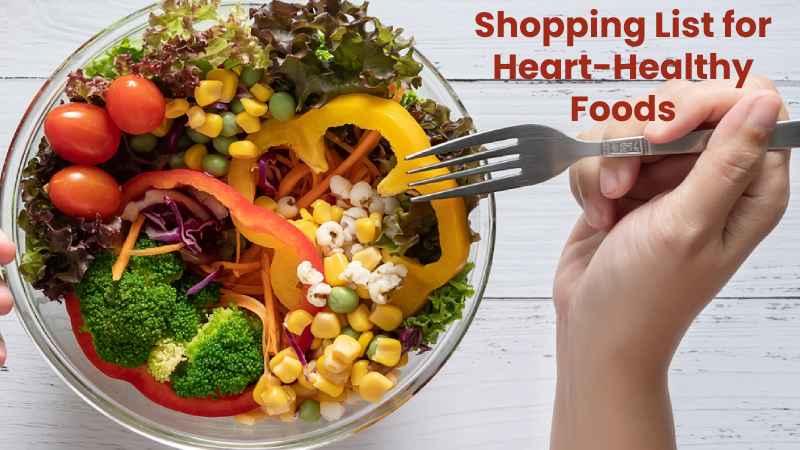Healthy Foods
Table of Contents
Shopping List for Heart-Healthy Foods
What you eat affects your heart. So follow these heart-healthy eating guidelines:
Consume less saturated fat. Reduce your consumption of fatty meats and high-fat dairy products. Pizza, burgers, and creamy sauces or gravy should remain avoided.
Reduce your sodium intake (salt)—the Nutrition Facts label and select foods with lower sodium levels. Look for “low sodium” or “no salt added” foods, such as some canned soups, canned vegetables, packaged meals, and snack foods.
Consume more fiber. Consume vegetables, fruits, beans, and whole grains to increase your fiber intake.
Take this list with you the next time you go shopping for groceries. Healthy Foods to Implement into Your Daily Routine

Fruits and vegetables
- Consume various vegetables and fruits, including fresh, frozen, canned, or dried options.
- Tomatoes, cabbage, and carrots are examples of fresh vegetables.
- Salad leafy greens such as Romaine lettuce, spinach, and kale
- Canning vegetables with low sodium
- Broccoli and cauliflower, for example, are frozen vegetables with no added butter or sauces.
- Apples, oranges, bananas, pears, and peaches are examples of fresh fruits.
- Fruit that has been canned, frozen, or dried without added sugars
Farmers’ markets are excellent places to purchase seasonal vegetables and fruits. Locate a farmers market near you.
Dairy Products
Look for fat-free or low-fat dairy products.
- Milk that is fat-free or low-fat (1%)
- Plain fat-free or low-fat yogurt
- Cottage cheese or fat-free or low-fat cheese
- Soy milk remains fortified with calcium, vitamin D, and vitamin A
Grain Whole
Make sure whole wheat or another whole grain is listed first in the ingredient list for products with more than one ingredient. Aspect for products that say “100% whole grain.”
- Bagels, English muffins, and tortillas made from whole grains
- Hot or cold whole-grain breakfast cereals with no added sugar, such as oatmeal or shredded wheat
- Brown or wild rice, quinoa, or oats are examples of whole grains.
- whole-wheat or whole-grain pasta and couscous
Proteins
Choose a variety of protein-rich foods.
- Fish and shellfish are examples of seafood.
- Poultry, skinless chicken or turkey breast, or lean ground chicken or turkey
- Lean cuts of meat, such as pork shoulder, beef sirloin, or lean ground beef
- Black beans and garbanzo beans are examples of legumes, peas, and lentils
- Eggs
- Nuts, seeds, and nut butter that have not remained salted, such as almond or peanut butter
- Tofu
Healthy Oils and Fats
Substitute healthier unsaturated fats for saturated fat, such as seafood, nuts, seeds, avocados, and oils. Try these healthy substitutions:
Cooking with vegetable oil (canola, corn, olive, peanut, safflower, soybean, or sunflower) instead of butter
Instead of full-fat mayonnaise, use low-fat or light mayonnaise.
Instead of creamy dressings like ranch, use oil-based salad dressings like balsamic vinaigrette or Italian.
Vegetable oils are generally healthy choices; however, coconut and palm oils are high in saturated fat and should remain avoided. Also, margarine and other soft spreads may contain less saturated fat than butter; check the Nutrition Facts label for options with less saturated fat.
Also read: Unicorn Face Paint
Related posts
Featured Posts
Strategies for Handling Financial Emergencies Without Panic
Introduction Life has a way of throwing curveballs when we least expect them. One minute, you’re cruising along, and the…
Low-Cost Car Insurance
Low-Cost Car Insurance: The most economical national vehicle insurance earners are State Farm and USAA. For minimum-liability insurance, State Farm…


